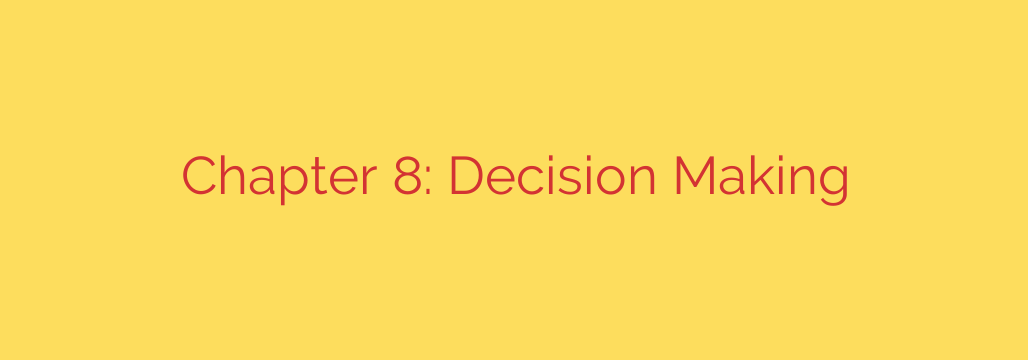
A Leader’s Guide to Effective Decision Making: Models, Biases, and Better Outcomes
Every day, we are faced with a continuous stream of choices. From minor operational adjustments to major strategic shifts, the quality of our decisions directly shapes our success. But how often do we stop to think about how we make those decisions? Improving your decision-making process is one of the most powerful levers you can pull to enhance performance, drive innovation, and avoid costly mistakes.
This guide explores the fundamental frameworks of decision-making, the hidden psychological traps that can lead you astray, and actionable strategies to help you make clearer, more effective choices.
Key Decision-Making Models: Which One Are You Using?
While it may feel like a single action, decision-making is a process. Understanding the different models helps you identify your own tendencies and choose the right approach for the situation at hand.
The Rational Model: The Ideal Scenario
This is the classic, step-by-step approach often taught in business schools. It involves identifying a problem, generating all possible alternatives, evaluating each one against clear criteria, and selecting the optimal choice. The rational model is logical and thorough but assumes you have perfect information, unlimited time, and are entirely free of bias—conditions that rarely exist in the real world.Bounded Rationality: The Realistic Approach
A more practical model, bounded rationality acknowledges our limitations. It suggests that we rarely seek the absolute best solution (optimizing) but instead search for one that is “good enough” (satisficing). We simplify complex problems, consider a limited range of options, and choose the first alternative that meets our minimum requirements. This model explains why we often make quick, satisfactory decisions instead of getting stuck in an endless search for perfection.The Intuitive Model: Trusting Your Gut
Intuitive decision-making is a subconscious process born from experience and pattern recognition. It’s that “gut feeling” that tells you something is right or wrong. While it can seem like a guess, intuition is often your brain rapidly processing past experiences to identify a familiar pattern. It is most effective when used by experts in their field who have a deep well of knowledge to draw from.
Beware of Hidden Traps: Common Decision-Making Biases
Our brains are wired to use mental shortcuts, but these can often lead to systematic errors in judgment. Being aware of these cognitive biases is the first step toward overcoming them.
Confirmation Bias: The tendency to seek out, favor, and recall information that confirms your pre-existing beliefs while ignoring contradictory evidence. To fight this, actively seek out dissenting opinions and play devil’s advocate with your own ideas.
Anchoring Bias: This occurs when you rely too heavily on the very first piece of information you receive (the “anchor”). All subsequent judgments and negotiations are skewed by that initial point, even if it’s irrelevant.
Overconfidence Bias: A pervasive tendency to be overly optimistic about the accuracy of our own judgments and knowledge. We often believe we know more than we actually do, which can lead to poor risk assessment.
Availability Heuristic: We tend to overestimate the importance of information that is easily recalled. Vivid, recent, or emotionally charged events feel more likely to occur, causing us to misjudge objective probabilities.
Escalation of Commitment: This is the dangerous act of continuing to invest time, money, or resources into a failing decision simply because you’ve already invested so much. Also known as the “sunk cost fallacy,” it’s about throwing good money after bad to avoid admitting a mistake.
Groupthink: In a group setting, the desire for harmony or conformity can result in an irrational or dysfunctional decision-making outcome. Team members may suppress dissenting viewpoints to avoid conflict, leading to a lack of critical evaluation.
Actionable Strategies for Sharper Decision-Making
Becoming a better decision-maker is a skill that can be developed. Here are some practical steps you can take to improve your process and outcomes.
Define the Problem and Your Goals Clearly. Before you jump to solutions, ensure you fully understand the issue. What specific outcome are you trying to achieve? A poorly defined problem almost always leads to a poor solution.
Expand Your Options. Don’t settle for the first two alternatives that come to mind. Push yourself and your team to brainstorm a wider range of potential solutions. The best choice might not be the most obvious one.
Seek Diverse Perspectives. Actively fight confirmation bias by consulting people with different backgrounds, expertise, and viewpoints. Encourage honest debate and create a safe environment for constructive disagreement. This is the best antidote to groupthink.
Consider the Long-Term Consequences. Avoid making decisions based solely on short-term gains. Step back and analyze the potential second- and third-order effects of your choice. How will this decision impact your team, your goals, and your organization in a year? Or five years?
Conduct a “Pre-Mortem.” Imagine it’s six months in the future and your decision has failed spectacularly. Get your team together and ask: “What went wrong?” This exercise helps identify potential weaknesses and risks in your plan before you commit.
Learn from Every Decision. After the outcome is clear, conduct a review. What went well? What didn’t? What did you learn? Treating every decision, good or bad, as a learning opportunity is crucial for continuous improvement.
By understanding the models that guide us, recognizing the biases that fool us, and implementing a structured, thoughtful process, you can transform decision-making from a source of anxiety into a powerful tool for success.
Source: https://linuxhandbook.com/courses/git-for-devops/git-branching/








